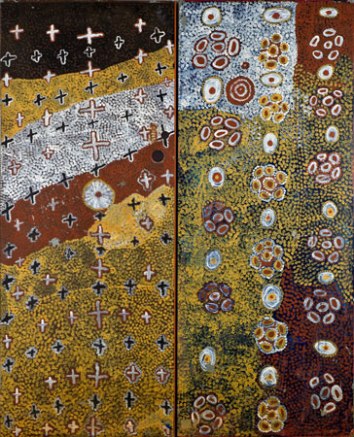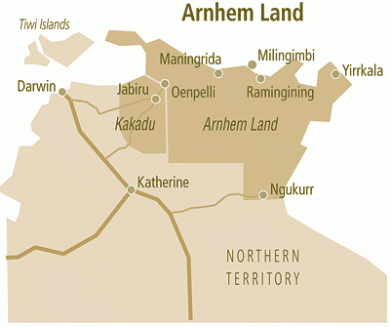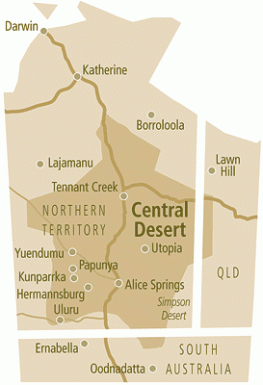For my last blog post I wanted to write about the different regional styles and techniques recognisable in Indigenous art. I think it’s really cool that some people can just look at an indigenous artwork and can tell you what region it’s from and what type of person painted it (male or female, or young or elder). I also think the way they use different symbols to tell stories is really interesting and I would love to be able to read a painting, and understand what’s going on. I’m way more interested in the traditional and historical side of the indigenous culture than the modern urban art and culture, and so I wanted to dedicate my last post to just that!
There is much diversity in the art that has come from the aboriginal art movement over the past 30 years. Particularly in some regions that are still very traditional in culture and language, this art still has a strong resemblance to that of the art that was produced before European contact. Other areas such as the central desert are more modern in their approaches and colours. This is also due to colonization. Since colonization the indigenous culture in some areas of Australia has been wiped out completely. In many coastal areas, the language has been wiped out, and so too has the culture, dance, and art. Regions now have to revive and recover their culture. But in central Australia, and the remote areas, the culture has been kept alive continuously throughout colonization, and their art really shows this. Some of the rock art work in the Kimberly region is an example of the oldest forms of humanity. The art from Arnhemland is very traditional and as I have said the central desert art is more modern. They are all very distinctive very different styles of Aboriginal art. But these too are evolving over time.
I’ll start of by examining the Central and Western Desert Art. Since the Papunya Tula Wesatern desert dot art movement began in the 1970’s desert art became bigger, brighter and bolder. Acrylic paint usually on large canvas or other materials, and a wide colour palette are features of the central desert art.
 Paddy Japaljarri Sims
Paddy Japaljarri Sims
Witi Jukurrpa (Ceremonial Pole Dreaming)
Acrylic on Linen, 122 x 76 cms
2007
Yuendumu school doors are another famous example of some central desert art. In 1983 some senior Walpiri men painted their sacred dreaming designs on the doors of a remote school in Yuendumu (see map). It was a key moment in Audtralia’s art history as it symbolised the Walpiri people’s decision to reveal and try to explain their tjukurrpa (dreaming) to the rest of Australia and the world. Originally 30 doors were painted, to teach the younger generations of aboriginal people of the sacred sites and stories of the dreaming. Over the time they have been used they have grown to tell stories of their own. Graffiti and other wear and tear markings shoiw unique documentation of the hostory of the school as well as stories of friendship and love.
 Image above: Door #17 – Ngatijirrikirli (Budgerigar) by Paddy Japaljarri Stewart
Image above: Door #17 – Ngatijirrikirli (Budgerigar) by Paddy Japaljarri Stewart
Moving up to the Kimberly region where colonisation hit hard, art depicts both contemporary and ancient features of landscapes and figurative, abstract and iconographic elements. The art depicts elements of recent history as well as figurative cosmology.They used a restricted colour pallet using natural pigments. One feature of the Kimbery art is that they often painted large blocks of colour outlined with white dots.Jimmy Pike and Rover Thomas who I’ve spoken about before are both from the Kimberly region.
Rover Thomas, Tokyo Crossroads, 1996.
Nancy Nodea, The Kimberlys, 140x100cm
 Arnhemland was one of the last regions in Australia to be colonised, and early contact was made with the people of Indonesia. Arnhemland is famous for its x-ray style painting such as skeletal bones or seing the insides of the animal or person. Also the cross hatching using natural ochre on bark, in plain earth tones such as red white and black are prominant features of Arnhemland art.
Arnhemland was one of the last regions in Australia to be colonised, and early contact was made with the people of Indonesia. Arnhemland is famous for its x-ray style painting such as skeletal bones or seing the insides of the animal or person. Also the cross hatching using natural ochre on bark, in plain earth tones such as red white and black are prominant features of Arnhemland art.
Gumatj at Yirrinyina by Madinydjarr Yunupinu 1998
Boyun, Bark Painting, Eucalyptus bark, natural earth pigments, Eastern Arnhemland, Northern Territory, Australia 88cm. x 42cm.
I love the intricate and detailed cross hatching of the Arnhemland paintings and I think they are my favourite.
So this was just a very short introduction into the different regional styles of Indigenous art but I really enjoyed reading and learning about it and I think the bark paintings in particular are extrodinary. I would like to look into it a bit more, who knows maybe I will write about it for my essay… Still undecided.
🙂
Figure 1 http://www.aboriginalartprints.com.au/regions_details.php?region_id=2
Figure 2 http://www.warlu.com/exhibitions/?2007&p=3
Figure 3 http://www.samuseum.sa.gov.au/whatson/whattosee/permanent/aacg
Figure 4 http://www.aboriginalartprints.com.au/regions_details.php?region_id=5
Figure 5 http://www.artabase.net/exhibition/1105-mcculloch-s-contemporary-aboriginal-art
Fig 6 http://www.authaboriginalart.com.au/Artist.asp?Artist=Nancy%20Nodea#
Fig 7 http://www.aboriginalartprints.com.au/regions_details.php?region_id=1
Fig 8 http://worldoceanobservatory.org/content/ocean-art-and-literature






